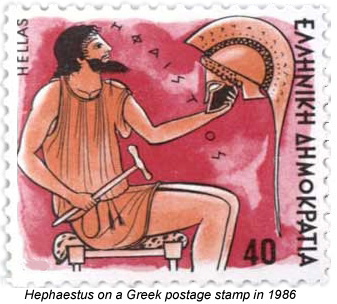...Best of Sicily presents... Best of Sicily Magazine. ... Dedicated to Sicilian art, culture, history, people, places and all things Sicilian. |
by Vincenzo Salerno | |||
Magazine Index Best of Sicily Arts & Culture Fashion Food & Wine History & Society About Us Travel Faqs Contact Map of Sicily
|
Unlike Hades and Polyphemus, Hephaestus rarely posed a danger to gods or mortals. His realm was simply a cavern with a forge. He was the blacksmith of the gods, and a patron of earthly smiths. One of his most important clients was Achilles. But he was also considered one of the gods of fire. In the Greek postage stamp shown here he is depicted with the hammer that has come to represent him. (Thor, the Norse god of thunder, also bore a hammer, but as a weapon and as a means of making the sound with which he is associated.) Two other figures, possibly of Ausonian or Sikel origin, are closely identified with Hephaestus and may be more ancient. These are Adranus on Mount Etna and Volcanos (not to be confused with the name Vulcanus or Vulcan) in the Aeolian Islands where one island bears the eponymous name Vulcano. Hephaestus was the son of Zeus and Hera - king and queen of the gods - and the husband of Aphrodite (the Romans' Venus), the goddess of beauty, who was unfaithful to him. Drawn from the Odyssey and other sources, Greek stories of Hephaestus abound, and as Vulcan his cult was popular among the Romans as well. He came to be known as the god of metallurgy, sculptors, volcanoes, artisans and technology in general. Vulcan, the Romans' Hephaestus, even created the thunderbolts of Jupiter. Though worshipped in Athens and in Sicily, the center of his cult was Lemnos, where he fathered two children by the sea nymph Cabeiro. In Greece a temple is dedicated to him. In Sicily he consorted with the nymph Aetna (alternatively Thalia) who bore him two sons, the Palici, gods of geysers worshipped around Mineo. Hephaestus fathered numerous children, both mortal and divine, including the robber Periphetes. Hephaestus fashioned Hermes' winged helmet and sandals, Helios' chariot, Aegis' breastplate, Agamemnon's staff, and the thrones in the Palace of Olympus. Accounts explaining Hephaestus' immobility (he moved about with the aid of a special chariot he constructed) vary widely. According to the most popular, as an ugly infant he was pushed from Mount Olympus into the sea by either Zeus or Hera, and was injured during the fall, breaking a leg that never healed properly and never learning to walk. Thetis, a sea nymph, found him and raised him as her own son. However, despite this archetypal "fall from grace," he is the only god to have ever returned to Mount Olympus after being exiled. Did he prefer Olympus to Etna? We do not know. Decorative iconography representing Hephaestus was popular on vases and other earthenware which probably made its way to Etruria where it influenced the Etruscans (who called him Sethlans) and, in turn, the Romans. Indeed, Roman myths about Vulcan are as numerous as Greek tales of their Hephaestus, and in Rome his sanctuary was the Volcanal at the base of the Capitoline Hill. He was also worshipped by strong cults at Ostia near the sea and the volcano of Pozzuoli near Naples. Perhaps the most enjoyable story about Hephaestus is the one describing his discovery of Aphrodite's unfaithfulness. Helios, the all-seeing sun god, told Hephaestus of Aphrodite's love affair with Ares, so the blacksmith lay a trap in the form of a metal net that ensnared the two. He dragged the naked lovers to Olympus, to the amusement of all present, where Poseidon, the sea god, persuaded Hephaestus to free them if Ares would pay the fine for adultery. About the Author: Palermo native Vincenzo Salerno has written biographies of several famous Sicilians, including Frederick II and Giuseppe di Lampedusa. | ||
Top of Page |
 Hephaestus, who
the Romans called Vulcan, enjoys a privileged place among the
Hephaestus, who
the Romans called Vulcan, enjoys a privileged place among the